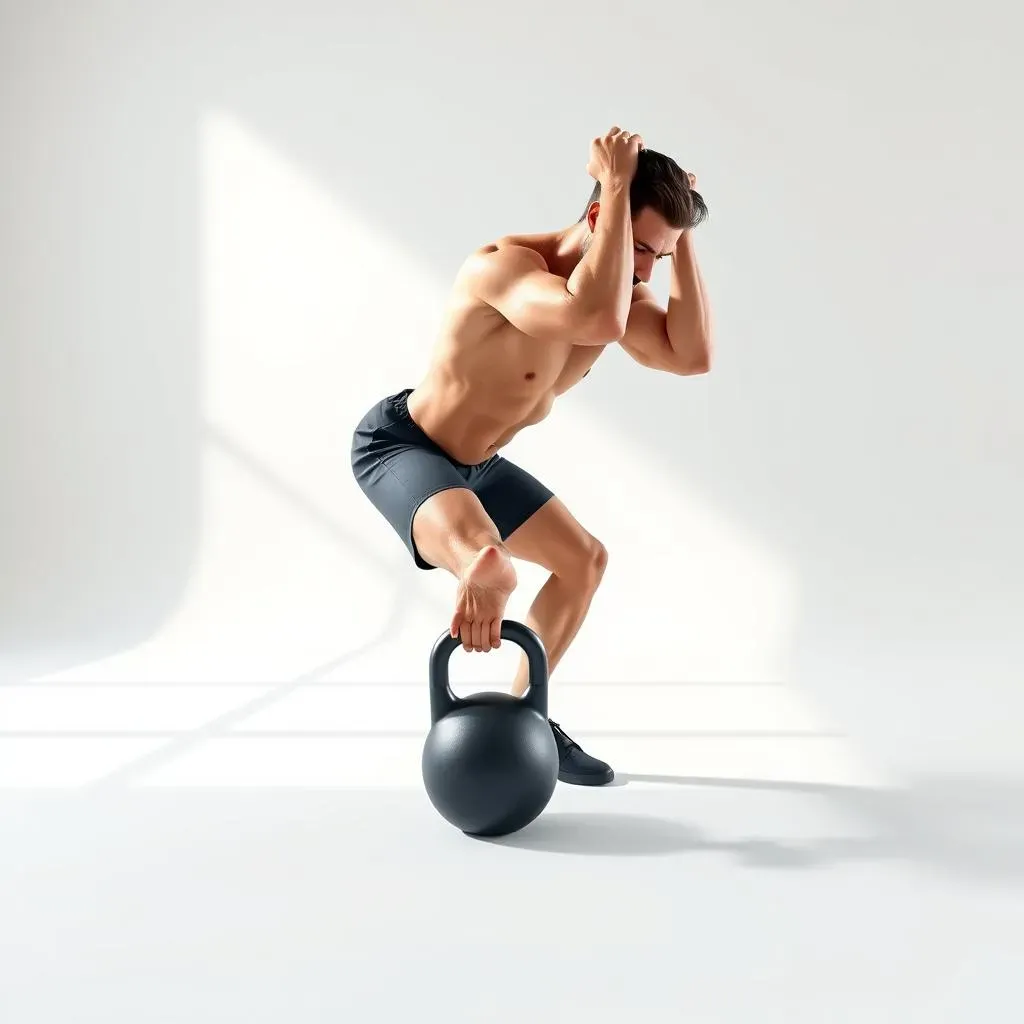Table of Contents
Forget endless crunches! If you're looking for a way to truly challenge your core and get real results, it's time to pick up a kettlebell. We're not talking about those boring, repetitive ab exercises here. A strong core isn't just about having a six-pack; it's the foundation for a healthy, injury-free body, and it can improve your performance in everyday activities. This article will guide you through the best kettlebell ab workout, using dynamic movements that target every part of your midsection. I'll explain why these exercises are so effective and break down the specific muscles you'll be working. We'll explore nine different kettlebell exercises, from the basic swing to the more challenging Turkish Get Up, and I'll show you how to do them correctly. Get ready to ditch the mat and discover a new way to build a stronger, more powerful core with the best kettlebell ab workout.
Understanding Your Core Muscles

Understanding Your Core Muscles
Why Core Strength Matters
Okay, so when we talk about "core," we're not just talking about those six-pack muscles you see in magazines. It's way more than that. Your core is like the powerhouse of your body; it's a group of muscles that work together to stabilize your spine, help you move, and protect you from injury. It includes muscles in your abs, back, hips, and even your glutes. Think of it as the central hub that connects your upper and lower body, keeping everything balanced and working smoothly. Without a strong core, you're like a car with wobbly wheels – you might get by, but you won't be performing at your best.
I know, I know, it sounds like a lot of fancy anatomy talk but just think of it like this: it's the reason you can stand up straight, pick up heavy stuff, and even twist to reach something behind you. It's not just about looking good; it's about being functional and feeling strong. When your core is weak, you're more prone to back pain, poor posture, and even injuries during workouts. So, building a strong core is an investment in your overall well-being.
What Muscles Make Up Your Core?
Let's get a bit more specific about the players in your core. First, you've got the rectus abdominis, those "six-pack" muscles that run down the front of your belly. Then there's the transverse abdominis, which is like a natural weight belt that wraps around your midsection, providing stability. You've also got the internal and external obliques on the sides of your torso. These help you twist and bend. Finally, the pyramidalis, a small triangular muscle, assists the rectus abdominis. All these muscles work together, like a well-oiled machine, to keep your body stable and strong. It's not just about the front of your body, either. Your back muscles like the erector spinae also play a huge part in core strength, working in tandem with your abs.
These muscles don't work in isolation, they're all connected. When you do exercises that challenge your core, you're not just working one muscle, you're engaging a whole system. That’s why moves that involve multiple muscles at once, like kettlebell exercises, are so effective. It's about getting all of those muscles firing together to create a solid, stable core. Think of it like a team working together to achieve a common goal, with each muscle playing a crucial role.
Core Muscle | Function |
|---|---|
Rectus Abdominis | Flexes the spine (the "six-pack" muscles) |
Transverse Abdominis | Stabilizes the spine and abdomen |
Internal Obliques | Assists in rotation and lateral flexion |
External Obliques | Assists in rotation and lateral flexion |
Pyramidalis | Assists the rectus abdominis |
Why Kettlebells Are Great for Core Work
Now, why use kettlebells for core work? Well, they're not just some trendy gym toy. Kettlebells are awesome because they force your core to work harder to stabilize your body during exercises. Unlike machines that often isolate specific muscles, kettlebell exercises are usually compound movements. This means they engage multiple muscle groups at once. This approach is not only more efficient, but also mimics real-life movements, making you stronger and more functional in everyday life. Plus, the offset weight of the kettlebell challenges your balance and stability, which activates your core even more. It’s like adding a new layer of difficulty to your workout, in a good way, of course.
The beauty of kettlebells is that they can take traditional core exercises to the next level. Think about a plank. Doing a plank is good, right? Now, try a plank while holding a kettlebell and moving it. Suddenly, you're not just holding a position; you're actively engaging your core to prevent yourself from toppling over. This is the kind of dynamic challenge that kettlebells provide, making your core stronger and more resilient. Kettlebells are like that friend who always pushes you to be better. If you are looking for the best kettlebell ab workout, you are in the right place.
9 Best Kettlebell Ab Exercises for a Strong Core

9 Best Kettlebell Ab Exercises for a Strong Core
Dead Bug with Kettlebell
Okay, so let's kick things off with the Dead Bug. Don't let the name fool you, it’s not as creepy as it sounds! This exercise is fantastic for learning how to engage your core while keeping your lower back pressed against the floor. To start, lie on your back with your arms extended towards the ceiling, holding a light kettlebell in one hand. Bring your knees up to a 90-degree angle, like you're sitting in an invisible chair. Now, slowly lower one arm and the opposite leg towards the floor, keeping your core tight and your lower back flat. It’s all about controlled movement here; no flopping around. Bring them back to the starting position and repeat on the other side. You'll feel your core working hard to stabilize you.
The Dead Bug is like a sneaky core workout. It looks easy, but it's actually pretty challenging when you do it right. The key is to maintain that connection between your lower back and the floor. If you feel your back arching, you're probably going too far. It's better to do a smaller movement with good form than a large movement with bad form. This is a great exercise for beginners, but even pros can benefit from it. It helps you build a solid foundation for more advanced core exercises. Remember, slow and steady wins the race with this one. It's a core stabilizer, not a core crusher.
Exercise | Benefit | How to do it |
|---|---|---|
Dead Bug with Kettlebell | Core stability, lower back engagement | Lie on back, lift arms and legs, lower opposite limbs while maintaining lower back contact with the floor |
Suitcase Carry
Next up, we have the Suitcase Carry. This one might seem too simple, but that's the beauty of it. Grab a kettlebell in one hand and just walk. That’s it! The key is to stand tall and resist the urge to lean to the side. Your core has to work hard to keep you upright and stable, especially on the side where you're holding the weight. It's like your body is saying, "Hey, I'm not going to let this weight pull me over!" This exercise not only strengthens your core but also improves your grip and overall stability.
I like to think of the Suitcase Carry as a real-life core workout. Think about carrying groceries or a heavy bag; you're using the same muscles. The kettlebell just adds an extra challenge. Start with a manageable weight and focus on maintaining good posture. Your shoulders should be back and down, and your core should be engaged. It's not about how far you can walk, but how well you can maintain your form. It's a great exercise to throw in between other exercises, or as a warm-up. It’s a sneaky core workout that will make you feel stronger and more balanced.
How to Incorporate Kettlebell Ab Workouts

How to Incorporate Kettlebell Ab Workouts
Starting Slow and Steady
Alright, so you're pumped to start slinging kettlebells around for those abs, that’s great, but let's not get ahead of ourselves. It’s important to remember that you don't need to go all out on day one. Start with a lighter weight than you think you need, especially if you're new to kettlebells or these types of exercises. Focus on getting the form down first. It’s like learning a new dance; you start with the basic steps, not the complicated choreography. You might feel a little silly using a light kettlebell at first, but trust me, it's better to master the movements with good technique than to struggle with a weight that's too heavy. Think of it as building a solid foundation before you start adding more weight to it.
Begin with just a few reps of each exercise, maybe 8-10, and do a couple of sets. You can always increase the reps, sets, or weight as you get stronger. Don’t be afraid to take breaks when you need them, especially when you start feeling the burn. Your body will tell you when it's time to stop, so listen to it. It’s not a race, it’s a journey. Also, consistency is key here. Doing a little bit regularly is way better than trying to cram a bunch of workouts into one day and then not doing anything for the rest of the week. So, start slow, be consistent, and watch your core get stronger over time. Remember, Rome wasn't built in a day, and neither are rock-solid abs.
Fitting Kettlebells into Your Routine
Now, where do these kettlebell ab exercises fit into your workout routine? Well, there are a couple of ways you can approach this. You can dedicate a specific day to core work, making it a focused session, or you can sprinkle these exercises into your existing workouts. If you’re doing a full-body workout, you could add a couple of these kettlebell moves at the end. If you're doing a cardio session, you could do a short circuit of core exercises after you finish. The key is to find what works best for you and your schedule. It’s all about being flexible and finding the right balance.
I'd suggest starting with 2-3 core-focused sessions per week, giving your muscles time to recover. You can do these exercises as part of a circuit, moving from one to the next with minimal rest, or you can do them as straight sets, completing all reps of one exercise before moving on to the next. Mix it up and see what feels best for your body. It's also a good idea to warm up before you start any core work. A few minutes of light cardio and some dynamic stretching will get your muscles ready to work. And of course, don't forget to cool down and stretch afterwards to help prevent soreness. Listen to your body and make adjustments as needed. It's your workout, so make it work for you. Remember, the best workout is the one you actually enjoy doing and can stick with long term.
Workout Frequency | Workout Structure | Warm-up | Cool-down |
|---|---|---|---|
2-3 times per week | Circuit or straight sets | Light cardio, dynamic stretching | Static stretching |
Progressing Over Time
As you get stronger, you'll want to challenge yourself to keep making progress. That's where the fun part starts! You can increase the weight of your kettlebell, the number of reps, or the number of sets you do. You can also decrease the rest time between sets. Another way to make things harder is to try more advanced variations of the exercises. Once you master the basic dead bug, you might try doing it with a heavier kettlebell or even adding a band for extra resistance. The key is to keep pushing your limits, but always in a safe and controlled manner. It’s about a gradual progression, not a sudden leap. You're not trying to become a superhero overnight, you're building a stronger, more resilient core over time.
Don't be afraid to experiment with different exercises and find what you enjoy. The more you enjoy your workouts, the more likely you are to stick with them. And remember, it’s not just about the physical aspect. Pay attention to how your body feels, and celebrate the progress you’ve made. It’s a journey, not a destination, and there’s always room to improve. So, keep challenging yourself, keep pushing your limits, and most importantly, keep having fun. Your core is going to thank you for it.